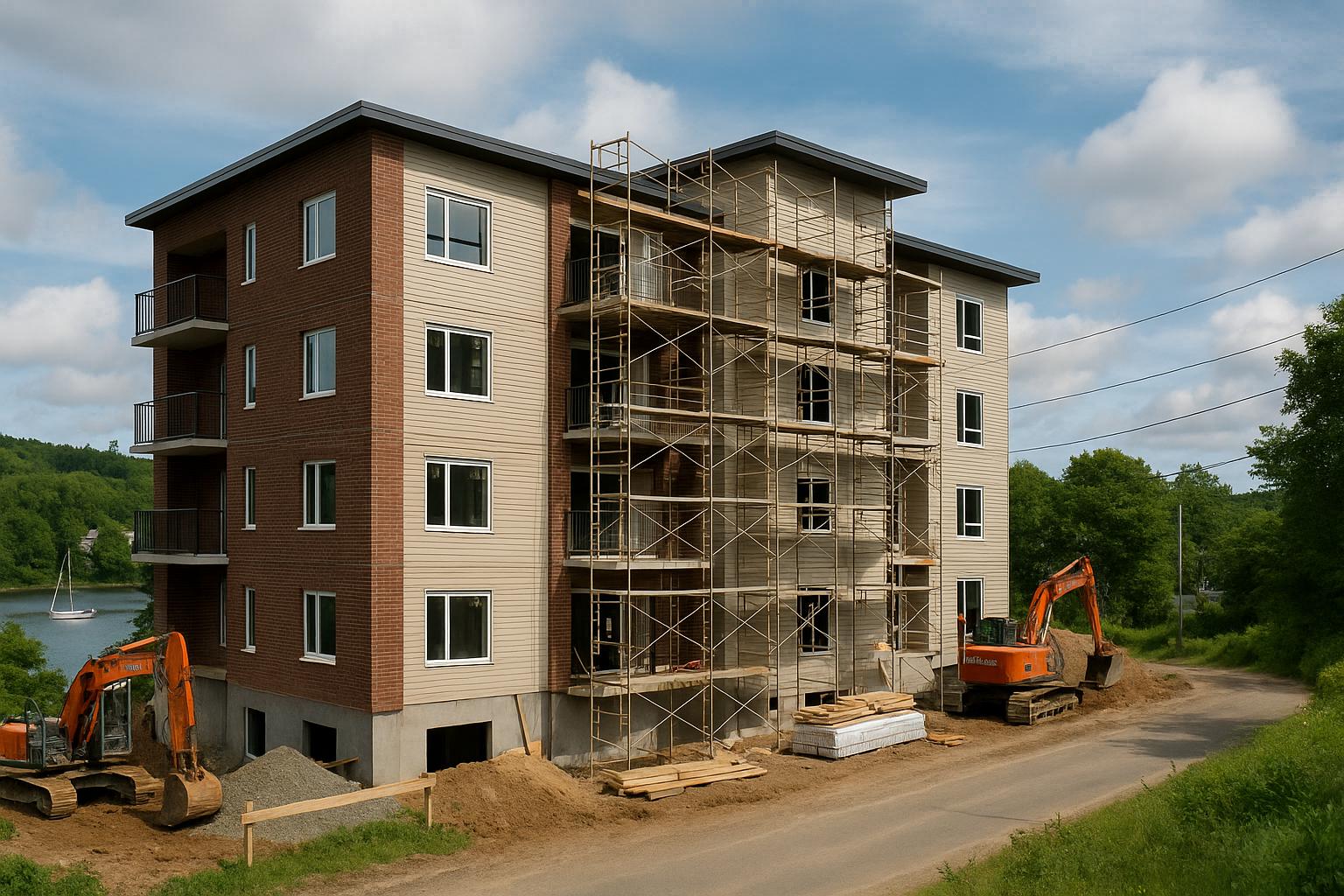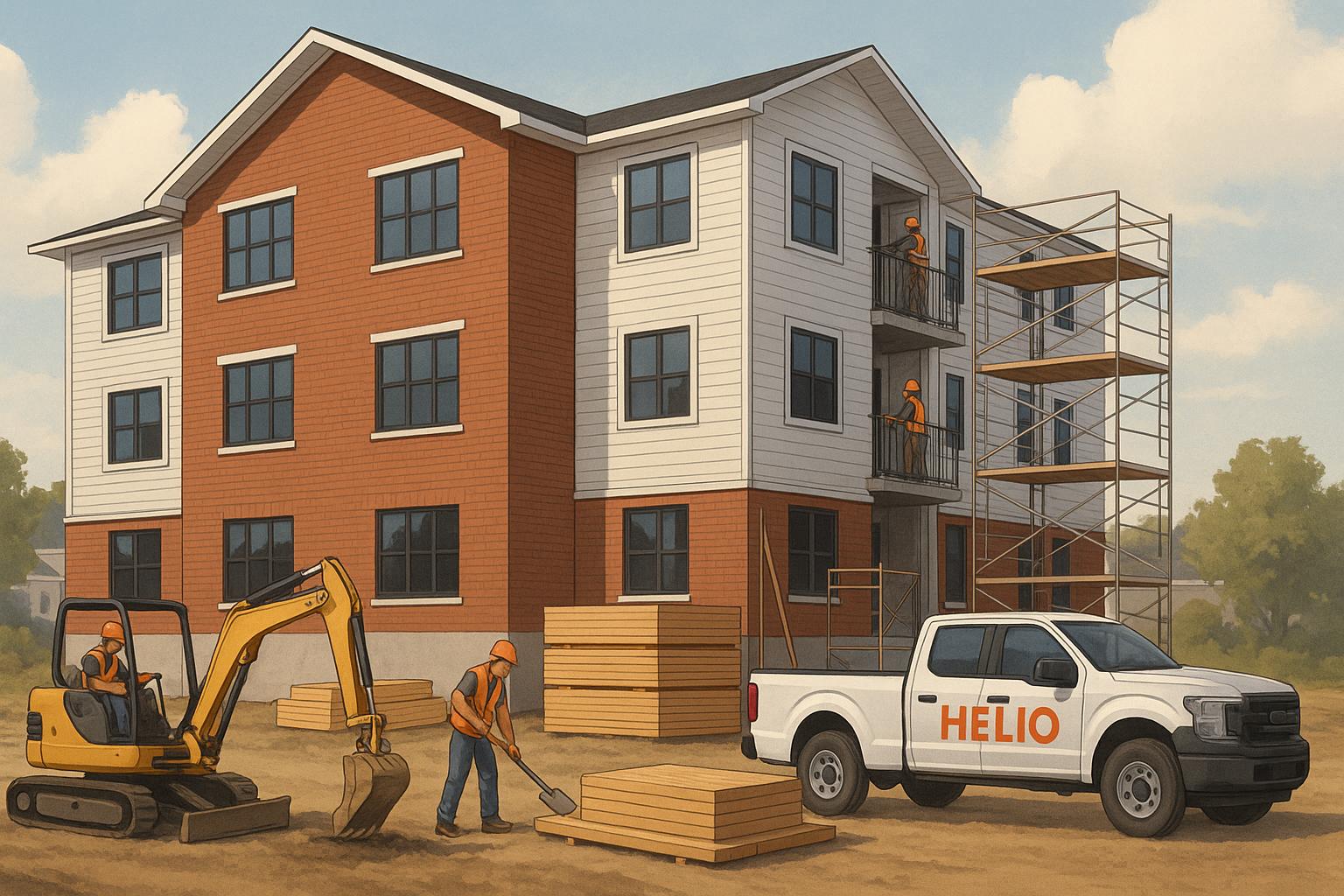Moving into your new Nova Scotia home? Here’s what you need to know right away:
- Warranty Coverage: Your home includes a 1-year full warranty for materials and workmanship, plus a 7-year structural warranty for major components like the foundation and roof.
- Seasonal Maintenance: Regular upkeep is crucial. Tasks like clearing gutters, testing HVAC systems, and monitoring humidity levels help maintain efficiency and comfort.
- First-Year Changes: Expect minor settling issues like drywall cracks or door adjustments - these are normal and often covered under warranty.
- Inspection Schedule: Key milestones include a 30-day inspection, seasonal check-ins, and a full review at the 1-year mark.
- Energy Efficiency: R-2000 systems improve indoor air quality and lower energy costs, but require regular filter changes and system checks.
Pro Tip: Keep warranty documents handy, track any issues, and schedule an 11-month inspection to address repairs before your warranty ends.
Understanding Home Warranties: Everything You Need To ...
Nova Scotia Home Warranty Coverage
The Atlantic Home Warranty program is designed to protect your investment with coverage split into specific phases. Here’s a breakdown of what’s included and how it works.
Warranty Coverage Details
The warranty provides one year of full coverage for materials, labour, finishes, fixtures, and installed systems. Additionally, major structural components like the foundation, load-bearing walls, and roof structure are covered for seven years. Coverage begins on the day you take possession of your home.
Warranty Documentation
When you receive your keys, you’ll also get a warranty package. This includes:
- Your warranty certificate with a unique registration number
- Details about the coverage phases
- Maintenance guidelines tailored to Nova Scotia’s climate
- Contact information for warranty support
Filing Warranty Claims
If you encounter a potential issue covered under the warranty, follow these steps:
- Take photos and detailed notes, including the date you noticed the problem.
- Contact the service team right away.
- Arrange for an assessment, which is usually scheduled within 5–7 business days.
For urgent issues like plumbing leaks or electrical problems, priority response is available within 24 hours.
Keep in mind: Routine maintenance tasks, such as changing filters or seasonal adjustments, aren’t covered under the warranty. However, the team is always available to provide guidance on maintenance and care.
Helio's After-Build Support
At Helio Urban Development, the real experience of homeownership starts when you get your keys. We’ve set up a support system designed to make settling into your new home as smooth as possible. Here’s what you need to know.
Home Inspection Schedule
Regular inspections help catch and fix issues early, keeping your warranty intact. Here’s what to expect:
- A detailed 30-day inspection to address any initial concerns.
- Seasonal check-ins to ensure systems are functioning properly.
- A full review at the one-year mark to assess your home’s overall condition.
These inspections focus on things like door alignments and mechanical systems, helping to maintain the quality of your home.
Industry Certifications
Helio is proud to be part of both the Atlantic Home Warranty program and the Nova Scotia Home Builders' Association, ensuring we meet high industry standards.
Getting Help from Helio
Need assistance? You can:
- Call our service line during business hours for support.
- Submit a request online for convenience.
- For urgent issues like major plumbing leaks, use our 24-hour emergency support line.
We keep track of all service requests to handle them quickly and effectively. Our team is here for you throughout your first year, ensuring your home stays in top shape.
Normal First-Year Home Changes
Moving into a new home often comes with its natural settling process. Knowing what to expect can help you differentiate between typical changes and those that might need professional attention.
Common Minor Changes
During the first year, it's normal for new homes to settle. Here are a few things you might notice:
- Drywall Shifts: Nail pops or tiny cracks in the drywall may appear as the structure settles.
- Doors Shifting: Doors might need adjustments due to changes in humidity levels.
- Squeaky Floors: Floors may develop squeaks as materials settle into place.
These are all common and are often influenced by local weather conditions.
How Weather Impacts New Homes
Nova Scotia's climate plays a big role in how new homes adjust:
- Humidity Swings: Coastal humidity can make materials expand and contract.
- Temperature Changes: Seasonal shifts in temperature naturally affect building materials.
- Moisture Control: Proper ventilation is key to managing moisture in maritime climates.
If these weather-related changes seem more serious, it’s important to address them through the warranty process.
What to Do if Repairs Are Needed
If you notice changes that require attention, here’s how to handle them:
-
Keep Records
Take photos of the issue, noting the date and any relevant weather conditions. -
Contact Us
Share the details with our team so we can assess the situation. -
Get It Fixed
For issues covered under warranty:- We'll address them during the one-year inspection.
- Urgent concerns will be prioritized.
- Repairs will be completed using high-quality materials and skilled workmanship.
sbb-itb-16b8a48
Seasonal Home Maintenance Guide
Helio's R-2000 technology is designed to keep your home efficient, but regular maintenance is key to preserving its benefits. Use this seasonal guide to tackle tasks specific to each time of year.
Fall Checklist
-
Exterior Tasks
- Clear leaves and debris from gutters and downspouts.
- Inspect roof shingles for any signs of damage.
- Store outdoor furniture and disconnect garden hoses.
- Clean window wells and ensure proper drainage.
-
Heating System Prep
- Schedule a professional HVAC inspection.
- Replace or clean furnace filters.
- Test your heating system before the cold sets in.
- Check weather stripping around doors and windows to prevent drafts.
-
Safety Essentials
- Test smoke and carbon monoxide detectors.
- Ensure exterior lighting is working as daylight hours grow shorter.
- Inspect fire extinguishers for proper functionality.
Winter Checklist
When temperatures drop, focus on staying safe outdoors and comfortable indoors.
-
Snow and Ice Management
- Keep snow and ice away from heat pump units.
- Clear snow from basement window wells.
- Ensure all exit paths are free of snow for safe access.
- Watch for ice dams on the roof.
-
Indoor Comfort
- Maintain indoor temperatures between 20–22°C.
- Keep humidity levels between 30–45%.
- Seal any drafts around windows and doors.
- Ensure your HRV system is ventilating properly.
-
Emergency Prep
- Stock up on emergency supplies.
- Test your backup generator monthly.
- Make sure the main water shut-off valve is easily accessible.
Spring and Summer Checklist
-
Exterior Maintenance
- Check for winter damage to your home’s exterior.
- Wash windows and screens for a fresh start.
- Inspect the foundation for any cracks.
- Test outdoor faucets and irrigation systems for proper function.
-
Ventilation and Cooling
- Clean or replace HRV filters.
- Check exhaust vents for blockages.
- Service air conditioning units.
- Confirm attic ventilation is working effectively.
-
Energy Checks
- Monitor the performance of your cooling system.
- Inspect attic insulation for wear or gaps.
- Replace HVAC filters as needed.
- Check weather stripping on doors and windows to maintain efficiency.
Regular maintenance ensures your home stays efficient and comfortable throughout the year.
Managing Home Energy Use
Your custom home's energy-efficient systems are designed to lower usage and enhance comfort. These strategies work hand-in-hand with your seasonal maintenance tasks.
HVAC and HRV Maintenance
To keep your home's R-2000 certified system running smoothly, stick to the manufacturer’s instructions. Regularly clean or replace HVAC filters and ensure HRV vents remain unobstructed.
Reviewing Monthly Energy Costs
Keep an eye on your monthly energy bills to identify patterns or sudden spikes. This can help you quickly address any inefficiencies or unexpected issues.
Operating Energy Systems
Make the most of your energy system by using programmable thermostats and ensuring proper ventilation throughout your home. This helps maintain efficiency and comfort.
Using Your Warranty Coverage
Make the most of your warranty to safeguard your new home investment.
Warranty vs. Regular Maintenance
Your home warranty is designed to cover defects in materials and workmanship, while regular upkeep of your home remains your responsibility. Here's a quick comparison of what typically falls into each category:
| Warranty Coverage | Regular Maintenance |
|---|---|
| Structural defects | Changing HVAC filters |
| Material failures | Cleaning gutters |
| Construction flaws | Lawn care |
| Installation issues | Snow removal |
| Building code violations | Cleaning windows |
As your warranty period nears its end, consider conducting a detailed 11-month inspection.
11-Month Home Review
Before your warranty expires, focus on these areas during your inspection:
- Foundation and Structure: Look for cracks or signs of settling.
- Windows and Doors: Ensure they operate smoothly and check for drafts.
- Plumbing Systems: Inspect for leaks or drainage problems.
- Electrical Systems: Test outlets and light fixtures.
- Interior Finishes: Note any drywall cracks or nail pops.
If you spot any issues, submit a service request right away.
Submitting Service Requests
Here’s how to handle service requests efficiently:
-
Document the Issue
Take clear photos and jot down when the problem first appeared. -
Contact the Warranty Department
Use the dedicated warranty service system to submit your request. Attach all relevant documentation and mention your preferred inspection times. -
Schedule an Inspection
The warranty team will evaluate the problem, confirm coverage, and provide a timeline for repairs.
"Morash Construction backs up every home with a one-year total-coverage warranty and a seven-year structural warranty with options to enhance coverage" [1].
Act quickly when issues arise to ensure timely and quality repairs.
Summary: First-Year Home Care
The first year in your new home is all about setting up care routines and making the most of your warranty coverage. Your warranty package kicks in from day one, helping protect your investment.
Key warranty milestones to keep in mind during your first year:
| Timeline | Action Items | Purpose |
|---|---|---|
| First 30 days | Document initial observations | Establish a baseline for your home |
| Quarterly | Perform seasonal maintenance | Prevent potential problems |
| Month 11 | Conduct a thorough inspection | Identify repairs covered by warranty |
These milestones emphasize the importance of regular upkeep. While the warranty addresses defects, consistent maintenance ensures your home retains its value.
What to track:
- Changes or issues you notice
- Maintenance tasks you’ve completed
- Communications about warranty claims
- Energy usage patterns
"Attention to detail is the watch-word in every Morash home. Every material used is carefully chosen for durability, performance and beauty, and installed by talented craftspeople." [1]
Your R-2000 certified systems are designed to provide healthier air and energy efficiency - but they need regular monitoring to perform at their best [1]. Keep warranty documents handy and submit service requests promptly to maintain your home's quality.
FAQs
How can I make the most of my new home warranty during the first year?
To get the most out of your home warranty in the first year, start by familiarizing yourself with what’s covered. Most new home warranties in Nova Scotia include coverage for materials and labour during the first 1–2 years, with major structural defects covered for up to 7 years. Make sure you understand the terms and timelines provided by your builder.
Throughout the year, keep an eye out for common settling issues, like small drywall cracks or doors needing adjustments. These are normal as the house adjusts to seasonal changes and are typically covered under warranty. To ensure you don’t miss anything, conduct a thorough inspection of your home around the 11-month mark and report any concerns to your builder before the warranty period ends.
Don’t hesitate to reach out to your builder if you notice anything unusual. They’re there to help, and addressing issues early can save time and stress later on.
How can I tell if an issue in my new home is normal settling or something that needs a warranty claim?
It’s normal for a new home to experience some settling during its first year, leading to minor issues like small drywall cracks or nail pops. These are typically caused by the house adjusting to seasonal changes and are often addressed under your new home warranty.
However, more serious problems, such as water leaks, uneven floors, or malfunctioning systems, could indicate a defect that requires immediate attention under your warranty. If you're unsure, it’s always best to contact your builder to confirm whether an issue is covered. Don’t wait - report any concerns before your warranty period ends to ensure they’re addressed promptly.
What seasonal maintenance tasks should I focus on to keep my home efficient and comfortable in Nova Scotia?
To keep your home running efficiently and comfortably throughout the year, focus on these seasonal maintenance tasks:
- Fall: Clean gutters to prevent blockages, winterize outdoor faucets, and service your heating system (furnace or heat pump) to prepare for colder months.
- Winter: Watch for ice dams on your roof, clear snow from basement windows and heat pump units, and test your generator to ensure it's ready for power outages.
- Spring: Inspect for any winter damage, service your HRV/ventilation system, and check your sump pump (if applicable) during the spring thaw.
- Summer: Wash salt or pollen off windows, maintain your landscaping, and keep an eye on outdoor features like decks and patios.
By staying on top of these tasks, you'll protect your investment and ensure your home remains comfortable year-round.
Related Blog Posts
- Building on the Nova Scotia Coast: How to Design and Construct Durable Seaside Home
- Common Mistakes to Avoid When Building a Home in Nova Scotia
- From Permits to Move-In: The Custom Home Building Timeline in Nova Scotia
- Designing Your Nova Scotia Coastal Dream Home: Embrace the Ocean, Resist the Elements



